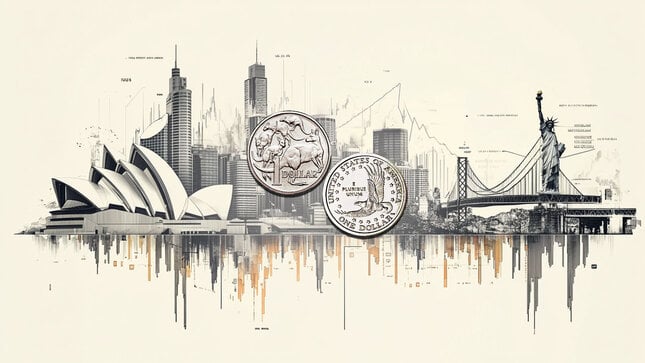The People's Bank of China (PBoC), National Financial Regulatory Administration (NFRA) and China Securities Regulatory Commission (CSRC) held a meeting on Financial Incremental Policies on Friday. The Chinese officials said they will implement incremental policies following a meeting on October 16.
Key quotes
Urges financial institutions to act swiftly in implementing expansive financial policies.
Necessary to increase credit support for the real economy and maintain reasonable growth in the total amount of money and credit.
Necessary to also strengthen the implementation and transmission of interest rate policies and solidly organize the batch adjustment of interest rates to reduce the stock of housing loans.
Boosting market confidence to be continued.
Emphasizes increasing support for financing small firms.
Market reaction
At the time of writing, AUD/USD is holding higher ground near 0.6705, adding 0.13% on the day.
Australian Dollar FAQs
One of the most significant factors for the Australian Dollar (AUD) is the level of interest rates set by the Reserve Bank of Australia (RBA). Because Australia is a resource-rich country another key driver is the price of its biggest export, Iron Ore. The health of the Chinese economy, its largest trading partner, is a factor, as well as inflation in Australia, its growth rate and Trade Balance. Market sentiment – whether investors are taking on more risky assets (risk-on) or seeking safe-havens (risk-off) – is also a factor, with risk-on positive for AUD.
The Reserve Bank of Australia (RBA) influences the Australian Dollar (AUD) by setting the level of interest rates that Australian banks can lend to each other. This influences the level of interest rates in the economy as a whole. The main goal of the RBA is to maintain a stable inflation rate of 2-3% by adjusting interest rates up or down. Relatively high interest rates compared to other major central banks support the AUD, and the opposite for relatively low. The RBA can also use quantitative easing and tightening to influence credit conditions, with the former AUD-negative and the latter AUD-positive.
China is Australia’s largest trading partner so the health of the Chinese economy is a major influence on the value of the Australian Dollar (AUD). When the Chinese economy is doing well it purchases more raw materials, goods and services from Australia, lifting demand for the AUD, and pushing up its value. The opposite is the case when the Chinese economy is not growing as fast as expected. Positive or negative surprises in Chinese growth data, therefore, often have a direct impact on the Australian Dollar and its pairs.
Iron Ore is Australia’s largest export, accounting for $118 billion a year according to data from 2021, with China as its primary destination. The price of Iron Ore, therefore, can be a driver of the Australian Dollar. Generally, if the price of Iron Ore rises, AUD also goes up, as aggregate demand for the currency increases. The opposite is the case if the price of Iron Ore falls. Higher Iron Ore prices also tend to result in a greater likelihood of a positive Trade Balance for Australia, which is also positive of the AUD.
The Trade Balance, which is the difference between what a country earns from its exports versus what it pays for its imports, is another factor that can influence the value of the Australian Dollar. If Australia produces highly sought after exports, then its currency will gain in value purely from the surplus demand created from foreign buyers seeking to purchase its exports versus what it spends to purchase imports. Therefore, a positive net Trade Balance strengthens the AUD, with the opposite effect if the Trade Balance is negative.
Information on these pages contains forward-looking statements that involve risks and uncertainties. Markets and instruments profiled on this page are for informational purposes only and should not in any way come across as a recommendation to buy or sell in these assets. You should do your own thorough research before making any investment decisions. FXStreet does not in any way guarantee that this information is free from mistakes, errors, or material misstatements. It also does not guarantee that this information is of a timely nature. Investing in Open Markets involves a great deal of risk, including the loss of all or a portion of your investment, as well as emotional distress. All risks, losses and costs associated with investing, including total loss of principal, are your responsibility. The views and opinions expressed in this article are those of the authors and do not necessarily reflect the official policy or position of FXStreet nor its advertisers. The author will not be held responsible for information that is found at the end of links posted on this page.
If not otherwise explicitly mentioned in the body of the article, at the time of writing, the author has no position in any stock mentioned in this article and no business relationship with any company mentioned. The author has not received compensation for writing this article, other than from FXStreet.
FXStreet and the author do not provide personalized recommendations. The author makes no representations as to the accuracy, completeness, or suitability of this information. FXStreet and the author will not be liable for any errors, omissions or any losses, injuries or damages arising from this information and its display or use. Errors and omissions excepted.
The author and FXStreet are not registered investment advisors and nothing in this article is intended to be investment advice.
Recommended content
Editors’ Picks

Gold price jumps to refresh record high above $3,070 amid Trump's tariff plans
Gold price hits a fresh all-time peak above $3,070 in the Asian session on Friday as escalating global trade tensions, the uncertainty over Trump's reciprocal tariffs, and the risk-off mood continue to drive safe-haven flows. Bets that the Fed will resume its rate-cutting cycle soon lend additional support to the bullion.

USD/JPY stays weak below 151.00 after hot Tokyo CPI; US PCE awaited
USD/JPY keeps the selling pressure intact below 151.00 in late Asian trading on Friday. Hot Tokyo CPI figures and BoJ's March Summary of Opinions ramp up BoJ rate hike bets, supporting the Japanese Yen. Meanwhile, tariff jitters undermine the US Dollat, bolstering the haven demand for the Yen. US PCE eyed.

AUD/USD drops below 0.6300 amid trade war fears
AUD/USD drops back below 0.6300 in Friday's Asian trading, undermined by broad risk-aversion due to US President Trump's latest auto tariffs announcements. Traders now look to the US PCE Price Index for some meaningful impetus. Hopes for more stimulus from China could cap the Aussie's decline.

Top 3 crypto gainers today: SUI,TONCOIN, Pi Network price predictions
SUI, Toncoin, and Pi Network have emerged as the top-performing assets among the top 20 ranked cryptocurrencies on Thursday. These altcoins saw impressive gains driven by fundamental developments, institutional interest, and growing community activity.

US: Trump's 'Liberation day' – What to expect?
Trump has so far enacted tariff changes that have lifted the trade-weighted average tariff rate on all US imports by around 5.5-6.0%-points. While re-rerouting of trade will decrease the effectiveness of tariffs over time, the current level is already close to the highest since the second world war.

The Best brokers to trade EUR/USD
SPONSORED Discover the top brokers for trading EUR/USD in 2025. Our list features brokers with competitive spreads, fast execution, and powerful platforms. Whether you're a beginner or an expert, find the right partner to navigate the dynamic Forex market.